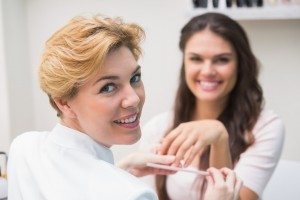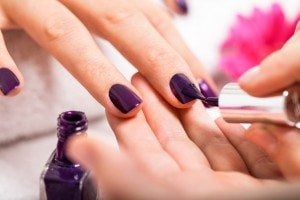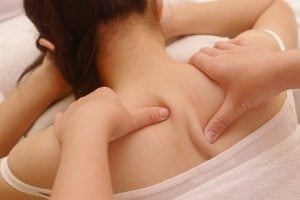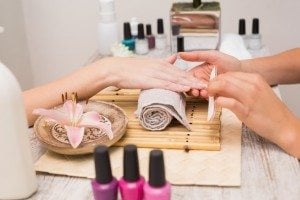If you are a recent school leaver, or even someone looking to making a career switch, you might be considering taking beauty therapy at college. College courses will provide you with all of the experience and professional qualifications that you need to work within the industry. This could be at a salon, as a mobile therapist or even on a cruise ship.
There are a great number of options available to aspiring beauty therapists. In this blog, we’ll run you through the steps needed to apply for a place on a college beauty course, show you what to expect from the initial interview, and provide you with a breakdown on the type of modules you can expect. We hope you find it useful.
Application
The first step that you will need to take in order to enroll on a college course, is to visit the college website and apply online. Usually you would do this prior to receiving your GCSE results; as colleges base their initial judgement on your predicted grades. You’ll be presented with an application form. Fill in your personal details until you get to a question that reads similarly to this:
‘Tell us why you should be given a place on the course you have chosen, and why we should consider you for the course. You should outline your career ambitions, personal interests and any work experience, including voluntary work:’
When answering this question, do your best to show the course that you are an enthusiastic, interested and hard-working candidate, who would be perfect for the industry. Let the college see how excited you are about a potential career as a beauty therapist, and they are sure to invite you to an interview.
When you arrive at your interview, you’ll be asked to fill in a questionnaire, which will test your basic knowledge on issues such as customer care. Then, you’ll be invited into a room to chat with one of the beauty lecturers at the college. The lecturer will interview you on your personal and professional interests, and discuss your enthusiasm for the course. You will be judged based on your appearance, oral expression, written expression, enthusiasm, personal hygiene and language. Try not to be nervous when interviewing for college, remember that this is not an ‘official interview’ so to speak, and as such you won’t be judged anywhere near as harshly as you would during a normal interview. In fact, it is highly unlikely that you will be rejected from the college; so just be yourself.
Course Structure
Based on your GCSE results, there are 2 categories which you can be sorted into:
Level 1 Diploma in Beauty
Grades needed: 5 GCSE’s, D to F or equivalent.
Level 1 Beauty is an entry level course, which teaches candidates how to assist and perform basic procedures in the workplace. This will include: basic facials, manicures and the application of day makeup. Based on their final results, candidates who are good enough will progress to Level 2.
Level 2 Diploma in Beauty
Grades needed: 5 GCSES, D’s and above
Level 2 Beauty is the normal entry point for candidates, and teaches candidates more advanced techniques than Level 1. It involves less assisting, and will show candidates how to perform treatments such as pedicure, advanced makeup and waxing. You’ll also be shown how to perform spray tans, eyebrow alterations and cleansing techniques.
After Level 2, candidates who are good enough will have the opportunity to progress to Level 3. This is a highly advanced programme which delivers more content and less assisting than any of the previous levels, and shows students how to perform treatments such as Indian heads massage, electro therapy and hot stone treatment.
On your college module, each level counts as a standalone qualification. For example, completing Level 1 will provide you with a Level 1 Diploma, and likewise for Level 2 etc. Generally, when applying for salon work, the minimum requirement is that candidates have achieved a Level 3. Your assessments will consist of both practical and written based examinations, which will take place at the end of each module, and at the end of the year.
In the next section, we’ll give you a breakdown of some of the modules you can expect to take on both level 2 and level 3 beauty courses.
Module Guide
Level 2
Health and Safety:
This is one of the most important, and fundamental modules that you will take. You should expect to see this module on every college curriculum. Unlike most of the below examples, the observation for this module will be judged both via a separate module, and during the other practical assessments. This is to demonstrate, alongside your other practical skills, that you have the ability to work with the utmost care and regard for both you and your clients welfare.
Sales and Promotion:
In this module you will be expected to demonstrate an ability to sell products to customers within the salon environment. For many salons, the ability to promote and sell these products is the difference between surviving and not surviving in the competitive world. Therefore, as a beauty therapist, is it crucial that you can demonstrate and possess the skillset required to do this.
Facial Skin Care Treatment:
In this module you would be expected to demonstrate an ability to perform procedures including: skin exfoliation, facial massage and mask treatment. You must be able to identify the correct procedure for the correct client, according to their skin type or condition. This module focuses heavily upon health, safety and hygiene standards.
Eyebrow and Eyelash Enhancement:
In this module you would be expected to demonstrate an ability to perform procedures such as eyebrow shaping, artificial lash treatment and eyebrow tinting. You must be able to identify the correct procedure for the correct client, according to skin tone or needs. This module focuses heavily upon health, safety and hygiene standards.
Level 3
Body Massage Treatment:
In this module you would be expected to demonstrate an ability to perform advanced massage treatments, such as massage of the head and body, and adapt and learn different massage techniques. The ability to identify the correct procedure for the correct client is more crucial in this module, and you must also be able to help the client prepare and plan for the treatment, and provide suitable aftercare advice. This module focuses heavily upon health, safety and hygiene standards.
Indian Head Massage:
In this module you would be expected to demonstrate an ability to perform Indian Head massage treatment, both with and without oils. The ability to identify the correct procedure for the correct client is more crucial in this module, and you must also be able to help the client prepare and plan for the treatment, and provide suitable aftercare advice. This module focuses heavily upon health, safety and hygiene standards.
For a more detailed and complete Level 2 and Level 3 module information, please purchase our comprehensive guide on how to become a beauty therapist





My girlfriend is looking at becoming a beauty therapist – so she will find this really useful! She’s been struggling to decide which beauty therapy course to take, as there are so many out there!
wow!! What a nice article.Thank you for giving us a such a good article.This is very informative article.